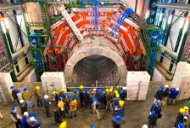The flood waters crept up. The lights went out. Yasar Onel and about a dozen of his students were not about to let angry Midwest weather wash away the University of Iowa's part in the world's largest physics experiment.
Post-docs Ugur Akgun and Taylan Yetkin helped take the lead grabbing the delicate quartz plates and read-out systems crucial for the CMS experiment at CERN and rushing for the van. "We were told we had two hours to leave before the highways were closed to traffic. So we packed as much as we could and headed for Fermilab," said Onel, an Iowa University professor and CMS collaborator.
What was usually a two and a half hour drive took over seven hours. When they arrived at Fermilab support came from all levels.
"They already knew our problem and took us in. They gave my students housing, did all the paperwork for shipment and let us complete our work in Lab 7," Onel said. "I couldn't believe all the support. The cooperation was really, really great."
The help enabled the group to make its deadline with CMS colleagues at CERN, preventing a possible test beam delay. Other researchers at the university weren't so lucky. More than 16 buildings flooded and officials expect it could take six months or more to replace or fix some equipment.
Fermilab has dozens of researchers and graduate students from the University of Iowa, where flooding blocked routes to airports and caused an estimated $250 million damage to the school. Most of the high-energy physics buildings escaped damage, but some high-energy physics and astronomy offices in the Iowa Advanced Technology Laboratory flooded, as did the homes of professors and graduate students working with Fermilab.
"We had very difficult time preparing our CMS/SLHC upgrade and CMS Forward Calorimetry projects and set-ups due to the floods," Onel said. "Thanks to Fermilab, we have received our detectors on time and we could start our test beam effort at the CERN H2 test beam facility on July 1st. We had a very successful running period."
You can help the university through the UI Flood Relief Fund. You can also view the most up-to-date information on the flood repairs and for a large gallery of photos at the University's flood information Web site.
By Jennifer L. Johnson, Fermilab intern
This story first appeared in Fermilab Today on July 15, 2008.











